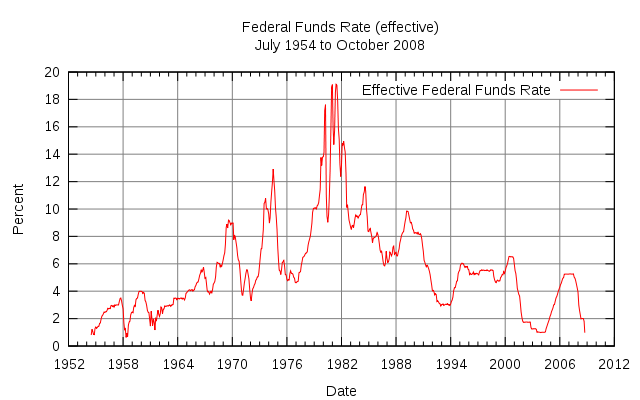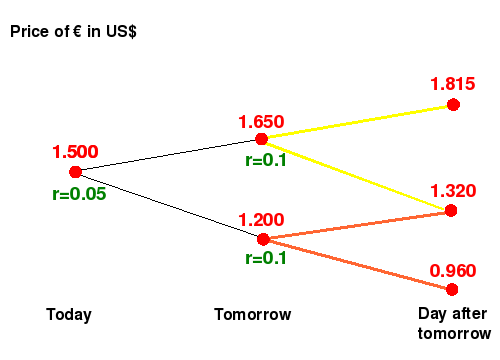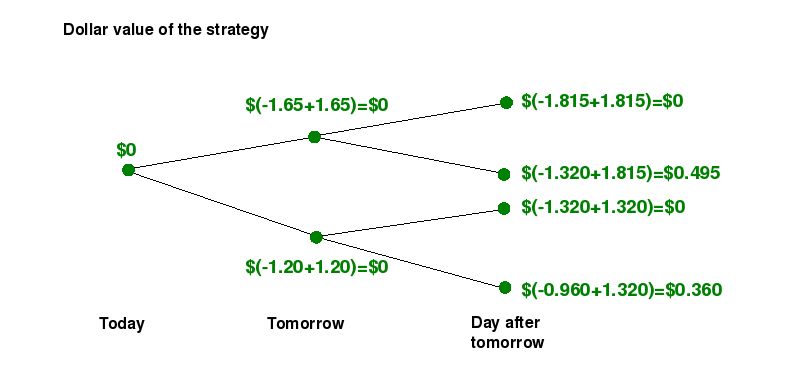The federal fund
rate is the interest rate at which depository institutions
(typically banks) lend money to other depository institutions over
night. With the aim at regulating the supply of money in the U.S.
economy, the Federal Open Market Committee (FOMC) periodically sets a
target for the federal fund rate, which is then determined by open
market.
In the
multi-period
model considered in module 1 we assumed that the interest
rate
r and the rates of return
d
and
u were constant over time. When trading bonds,
the main source of risk in the market comes from the changes over time
on the spot interest rate
r, and hence is not very
accurate to assume this rate to be constant over time. Over long
periods of time, even in the stock market, the assumption of constant
interest rates might be too restrictive (the figure below shows the
federal fund rates between July of 1954 and October of 2008, see
tangent). Additionally, when looking at price movements in the stock
market it becomes clear that the rates of return over time can not be
modeled by just using the two variables d and u. In the present lesson
we will restate the fundamental theorem of asset pricing for time
dependent interest rates and rates of return. This extension appears to
be very simple by it turns out to be very useful, since more robust
models can be used in this framework.

Example: Dollar
Vs Euro with time dependent interest rate
Suppose that
the exchange rate of the Euro against the dollar is as in the
multi-period model presented in
lesson
1. Assume that today the interest rate on the Dollar is 5%,
but tomorrow it changes to 10% (see figure below). Assume further that
the interest rate on the Euro is 0% for the next two days. By the
considerations made in module 1 we know that this model is arbitrage
free for the first period of time. One might ask then:
is this model, in which interest rates on
the dollar depend on time, arbitrage free over the two days time
horizon as well?
The answer to
this question is negative because the interest rate in the second
period is not strictly between the rates of return
u=0.1
and
d=-0.2. An example of an arbitrage opportunity
is the following: do not trade today, wait until tomorrow to
short-sell
€1 and lend the selling price in dollars. This strategy represents an
arbitrage opportunity, the value of the strategy at different times is
given in the diagram below.

This example
illustrates the following fact: a
market model is arbitrage free if and only if every one step submodel
is arbitrage free as well. In the case above, the one-step
submodels obtained when the price goes either up or down
(highlighted with yellow and orange in the figure above) are not
arbitrage free and neither is the two-step model.
Activity
1
-
Suppose that the stock's price of General Motors is as in lesson
2. Assume that the dollar's interest rate today is 0%, but
tomorrow it is 1%. Determine if this market is arbitrage free. In case
it is not, give an example of an arbitrage opportunity.
- Suppose now that the stock pays
1% of dividend on each dollar invested
between tomorrow and the day after tomorrow (see lesson
7). Is in this case the market arbitrage free?
The Fundamental
Theorem for time dependent interest rates and rates of return
As we already
mentioned above in order to guarantee the nonexistence of an arbitrage
opportunity in a multi-step model it is necessary and sufficient to
guarantee the arbitrage free condition over the one-step submodels.
This results applies not only when interest rates change over time, as
we saw in the example presented above, but also when the rates of
return on the risky asset are time dependent as well. In general, if we
have a model with a riskless asset with time
dependent interest rate rt
and price process St0=(1+rt)t,
and a risky asset with time
dependent rates of return, dt<
ut, each of which can be realized at
any time with positive probability, and price process St,
the market is arbitrage-free if and only if at any time t

which holds if
and only if the discounted price process

is a
martingale
with respect to the risk
neutral probability, that at each time t gives the
probability (rt-dt)/(ut-dt)
to the realization of the rate of return ut.
A natural generalization of this result can be obtained for multi-asset
markets (see
lesson
8).
The statement of this
generalizatation is left as an exercise for the reader.
Also notice that the result above allows us to study models in which
dividend payments on the risky asset are not paid at each time (see
lesson
7). For instance assume that in the example above the
interest rate on the Euro is 0% today but 10% tomorrow. This pushes up
the rates of return on the Euro tomorrow, from
d1=-0.2
and
u1=0.1, to
d'1=-0.12u'1=0.21
(see
lesson
7). Therefore the arbitrage condition of the fundamental
theorem is satisfied and the model is arbitrage free (observe that the
strategy exhibited above is no longer an arbitrage opportunity under
this circumstances).
Activity
2
- Verify your answer in part b)
of activity 1 by using the fundamental
theorem for time dependent interest rates and rates of return.
- Generalize the fundamental
theorem for time dependent interest rates
and rates of return, when there is more than one risky asset in the
market (see lesson
8).
Pricing
European type claims
The theorem
stated above also reveals how to price contingent claims in models with
time dependent interest rate and rates of return. According to the
fundamental theorem, the price at time t of a
contingent claim with payoff CT
at maturity time T is equal to

where
Q*
is the probability, that at each time
t gives the
probability
(rt-dt)/(ut-dt)
to the realization of the rate of return
ut.
For instance, suppose that the stock of GM behaves as in
lesson
2, the interest rate over time is given by
r0=0
and
r1=0.01. Assume further
that GM pays $1.01 for each dollar invested in the stock between
tomorrow and the day after tomorrow. In this case the rates of return
are
d0=-0.03,
u0=0.01,
d1=-0.0203 and
u1=0.0201
(see
lesson
7). The risk neutral probabilities of the high rates of
return today and tomorrow are
(0+0.03)/(0.01+0.03)=0.75
and
(0.01+0.0203)/(0.0201+0.0203)=0.75,
respectively. In this case the price today of a
European
call option with maturity the day after tomorrow and strike
10*0.97
is

Activity
3
-
Find the prices tomorrow of the call option described above (see lesson
8).
- Consider the same model as in
the example above. Find today's price of
a straddle
on the GM stock.